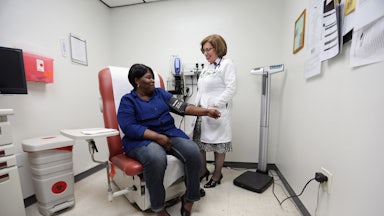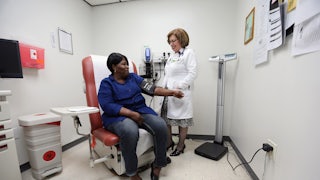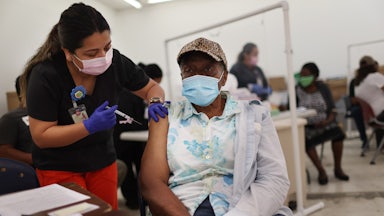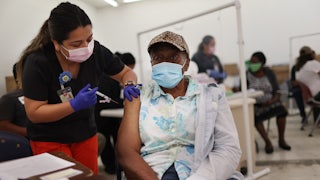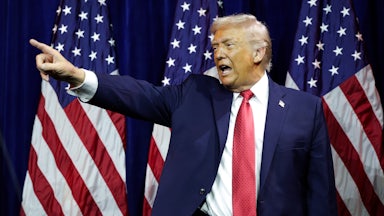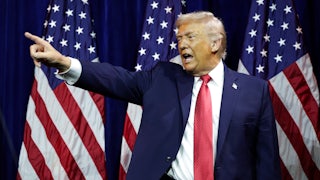A shocking report in Politico earlier this month warned of an impending doomsday scenario: Unless the disaster is somehow averted, more than 15 million people are at risk of getting booted off Medicaid coverage beginning in mid-April. That’s nearly a fifth of the program’s current enrollees.
The imminent crisis is two years in the making. In early 2020, surging pandemic-related unemployment (not to mention the pandemic-related pandemic!) suddenly made it terribly inconvenient to have a health care system for which both access and financing is convolutedly routed through private insurance. A whole lot of dominoes might have toppled awfully fast: With millions of people slated to lose employer-sponsored or individual insurance plans, as well as the income necessary to purchase alternative coverage, a sizable portion of the population was not just on the brink of losing their entry point into the health care system at the very moment a novel pathogen ripped across the earth, but the hospitals responsible for these patients’ care were poised to see revenue crater and a broader struggle to continue operating ensue.
What happened instead was astonishing in retrospect. Instead of allowing this cataclysm to occur, the government took action and expanded unemployment insurance benefits so significantly that tens of millions of people actually saw their incomes rise. It moved to make most Covid-related care free at the point of use, and it subsidized hospitals directly. It picked up the full tab for Cobra coverage for people who lost insurance when they lost their jobs. It also shored up the Medicaid program to absorb still others who likely lost income but weren’t receiving health benefits through work, striving to smoothly accommodate inevitably rising enrollment by increasing federal funding to states in exchange for their commitment not to trim their rolls for the duration of the official “public health emergency.”
Two years later, the number of people insured through Medicaid is at an all-time high, and the public health emergency designation that fueled all this commonsense change is set to expire on April 15 (though the Biden administration has promised a 60-day warning before ending it, a deadline that has passed). Whenever it does eventually happen, the plug will get pulled on the supplemental federal cash, and states shall once again resume strict eligibility policing—thereby sending the loosened Medicaid restrictions out to pasture in the same way that the supercharged unemployment insurance, waived cost-sharing for Covid care, and free Cobra coverage disappeared before it. As the Department of Health and Human Services plays chicken with the looming deadline and state administrators get antsy with uncertainty, it’s worth noting: This is an absurd and avoidable disaster, and it’s not nearly as extraordinary a circumstance as officials will surely insist that it is.
The swift and timely implementation of the aforementioned social support provisions was an undeniable success, compared to what could have been: Large-scale impoverishment and health coverage loss were almost entirely averted in 2020. Some studies showed that by the end of that year, there had been a net-zero increase in the uninsurance rate—implying that pretty much everyone who lost coverage shifted fairly easily onto another plan soon afterward. For many commenters, this amounted to the ultimate validation of the Affordable Care Act, which had proven itself yet again after more than a decade of Republican shellacking. “Obamacare, in Its First Big Test as Safety Net, is Holding Up So Far,” asserted one New York Times headline. NBC News went even further: “Affordable Care Act filled need, fended off dismantling in 2020.”
But here’s what such rosy takes obfuscate: However much worse things could have played out in the era before Obamacare, the ACA’s apparent triumph throughout the pandemic happened only with the support of sturdy government training wheels. These temporary interventions—stamping out Covid cost-sharing, massively beefed-up Cobra subsidies to keep people on employer insurance, and the suspension of Medicaid eligibility recertification processes—were put into place explicitly because the threat of facing a once-in-a-century pandemic with the ACA functioning normally was rightfully considered unthinkable.
The ACA hasn’t actually weathered a big test or filled a gaping need on its own. Those accomplishments required the implementation of exceptional emergency provisions, which were necessary because the ACA itself was woefully insufficient. Looking back at the ways in which pandemic politics have evolved since those early days—and the moderate and right-wing obstructionism that’s blocked remotely comparable policy responses since—it’s tough to envision the ACA getting such a boost to help it through the next crisis. When it’s faced with its real first test as safety net, things are unlikely to go so well.
In some ways, the coming months may clarify to everyone exactly how our health care system actually works: Patients are once again facing out-of-pocket costs for intensive care unit treatment for Covid-19, averaging thousands of dollars a pop. Once stockpiles of antivirals run out, there is no measure yet in place to keep those treatments free. And if the public health emergency period does draw to a close as planned, millions of patients stand to be elbowed out of the coverage upon which they have relied. While the vast majority are eligible for alternate insurance, the level to which they’ll be notified and guided through a process of research and reenrollment is largely a function of whether their state is ideologically and financially invested in giving a damn. There’s no guarantee this process will be adequate. In one sobering comparison case, some 15,000 children eligible for alternate insurance were recently ousted from the Children’s Health Insurance Program in Utah; only 59 percent of them were successfully reenrolled elsewhere.
As scholars such as Georgetown’s Dan Moynihan and Pamela Herd have long begged us to understand, the ease by which patients can be shoved off welfare programs like Medicaid is by design; as is the way in which they are such a pain in the ass to deal with. The more obstacles thrown in the path of those trying to navigate the system, the more Medicaid can exclude people who don’t meet the rigid eligibility requirements and people who are bad at paperwork. When programs are means-tested, participants inevitably wobble above and below the line—a phenomenon called “churn” in health policy parlance—and it happened to around 12 percent of Medicaid enrollees every year before the novel coronavirus even existed.
An emergency forced us to think differently about the way we were dispensing health care. We found out that improving the status quo wasn’t a heavy lift at all. Suspending these relentless Medicaid eligibility patrols illuminated how a better system is possible—a patient-friendly intervention that right-wing analysts have derisively condemned as outfitting states with “Medicaid handcuffs.” But those so-called “handcuffs” were a key component of timely, life-saving pandemic relief, guaranteeing millions of people uninterrupted access to care. Let’s throw away the key.

